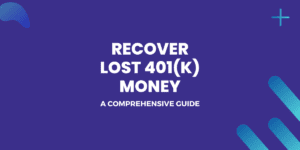In this article, “Terminated Employees: 401(k) Plans & Benefits Explained,” we will delve into the various options available to terminated employees concerning their 401(k) plans. These options include leaving funds in the current plan, rolling over to an IRA, transferring to a new employer’s plan, and the implications of cashing out.
By comprehending these choices and evaluating their respective pros and cons, individuals can make well-informed decisions that align with their long-term financial objectives, ensuring a secure retirement.
In such situations, it is crucial to grasp the consequences that arise for essential aspects of employment, like 401(k) plans and benefits.
A 401(k) plan acts as a fundamental pillar for retirement savings, permitting employees to contribute a portion of their pre-tax salary, often accompanied by employer-matching contributions. However, termination can trigger a sequence of events that demand careful consideration for an employee’s 401(k) plan.
What happens to 401(k) plans and benefits upon employee termination?
“When an employee faces termination, the future of their 401(k) plan and benefits is contingent upon various factors, including the employer’s rules and policies, as well as the terms outlined within the 401(k) plan itself.
Here are a few potential scenarios to consider:
Vested Balance: The vested balance, which denotes the portion of the account the employee is legally entitled to based on their years of service.
Employer Contributions: Employer contributions that have not yet been vested may be forfeited upon termination, with the treatment of unvested contributions varying depending on the plan. To gain precise information, referring to plan documents or consulting the plan administrator is essential.
Distribution Options: When it comes to distribution options, terminated employees generally have choices available. They can leave the funds in the existing plan, roll them over into another qualified retirement account, such as an Individual Retirement Account (IRA), to maintain tax advantages, or opt to cash out the 401(k) plan, though this may result in taxes, penalties, and loss of potential growth.
Loans: If the terminated employee had an outstanding loan from their 401(k) plan, the loan may need to be repaid in full shortly after termination. Failure to repay the loan could result in taxes and penalties.
For individuals to fully comprehend the impact of termination on their 401(k) plan and benefits, it is crucial to review their specific plan documents and seek guidance from the plan administrator or a financial advisor.”
Vesting and how it affects 401(k) plans
“Vesting holds significant importance in the realm of 401(k) plans as it influences an employee’s ownership rights pertaining to the contributions made by their employer. In the context of participating in a 401(k) plan, employees commonly receive contributions from both themselves and their employer.”
How vesting works and its impact on 401(k) plans
Vesting Schedule
A vesting schedule is a predetermined timeline or set of requirements set by the employer to determine when an employee becomes eligible for the employer’s contributions to their 401(k) plan. The specific terms of vesting schedules can differ between employers, establishing the duration an employee must work for the company before gaining entitlement to those contributions.
Cliff Vesting vs. Graded Vesting: There are two common types of vesting schedules: cliff vesting and graded vesting.
Cliff Vesting
Under cliff vesting, an employee attains full vesting in their employer’s contributions after a specific timeframe, such as three years. Until that point, they do not possess ownership rights over the employer’s contributions.
Graded Vesting
Graded vesting enables employees to progressively acquire ownership rights over their employer’s contributions. For instance, an employer may outline a schedule where an employee becomes 20% vested after two years, 40% vested after three years, and so forth, culminating in full vesting.
Impact on Ownership
When an employee achieves full vesting, they acquire complete ownership rights over their employer’s contributions to their 401(k) plan. Consequently, they retain these contributions, even if they leave the company or experience termination. In contrast, if an employee is not fully vested, there is a possibility of forfeiting some or all of the employer’s contributions that have not yet become vested.”
Employee Contributions
It is worth noting that employee contributions to a 401(k) plan are inherently fully vested. From the moment these contributions are made, the employee has complete ownership of them and can retain them even upon leaving the company.
Retirement Savings
Vesting plays a crucial role in an employee’s retirement savings strategy, serving as a recognition of loyalty and tenure. Employees ensure they maintain ownership of the employer’s contributions by satisfying the required vesting period.
Comprehending the vesting schedule of a 401(k) plan is vital for employees as it determines their ownership rights over the employer’s contributions. Full vesting empowers employees to optimize their retirement savings and capitalize on the benefits associated with their employer’s contributions to the plan.
What happens to the vested and non-vested portions of an employee's 401(k) balance upon termination?
When an employee is terminated, the destiny of their vested and non-vested parts of the 401(k) balance can differ based on the particular circumstances and the employer’s policies.
Here is an analysis of what commonly occurs:
Vested Balance
Retention: The vested section of an employee’s 401(k) balance belongs to the employee. It is unaffected by termination and remains intact.
Ownership: The employee can decide whether to keep their vested balance in the existing 401(k) plan or take steps to transfer it to another eligible retirement account, such as an Individual Retirement Account (IRA) or a new employer’s 401(k) plan.
Non-vested Balance
Potential Loss: The non-vested portion of the 401(k) balance generally does not belong to the employee upon termination. It may be forfeited according to the terms outlined in the plan’s vesting schedule.
Plan-specific Rules: The employer’s plan documents specify whether the non-vested portion is forfeited entirely or if it can be used to offset future contributions if the employee is rehired within a certain period.
Re-vesting: In some cases, if an employee is rehired by the same employer within a specific timeframe, they may regain the non-vested portion and continue vesting according to the plan’s provisions.
It is crucial for employees to review their employer’s 401(k) plan documents or consult with the plan administrator to understand the specific rules and implications regarding the treatment of vested and non-vested balances upon termination. These documents will outline the exact terms and conditions governing the handling of these funds and assist employees in making informed decisions about their retirement savings.
Significance of being fully vested and its impact on retaining employer contributions
Being completely vested in a 401(k) plan carries substantial importance for employees, particularly regarding the preservation of employer contributions. Here’s why full vesting holds significance:
Ownership of Employer Contributions: Full vesting signifies that an employee has fulfilled the criteria established by the employer’s 401(k) plan and has obtained complete ownership rights over the employer’s contributions. This encompasses employer-matching contributions and any other contributions made on the employee’s behalf.
Preservation of Employer Contributions: When an employee is fully vested, they possess the guarantee that they will retain the entire amount of the employer’s contributions in their 401(k) account, regardless of whether they depart from the company or are terminated.
These contributions are regarded as part of the employee’s retirement savings and can significantly impact their future financial security.
Retirement Savings Growth: By preserving employer contributions, fully vested employees can benefit from the potential growth and compounding of those funds over time. The longer the funds remain invested in the 401(k) account, the greater the opportunity for them to grow and contribute to the employee’s overall retirement savings.
Employee Loyalty and Rewards: Full vesting serves as an incentive for employees to remain with a company for an extended period. It rewards loyalty and dedication by ensuring that the employer’s contributions gradually become the employee’s property. This encourages employees to make long-term commitments to their employers, promoting stability and continuity within the workforce.
Impact on Retirement Readiness: The preservation of employer contributions through full vesting plays a vital role in an employee’s readiness for retirement. It provides an additional source of funds to supplement the employee’s own contributions and aids in building a substantial retirement nest egg. Without full vesting, employees may miss out on a significant portion of their potential retirement savings.
Employees should thoroughly review their employer’s vesting schedule and comprehend the requirements for full vesting. By meeting these requirements, employees can ensure they receive the complete advantage of their employer’s contributions, securing their financial future and enhancing their preparedness for retirement.
Options available to terminated employees regarding their 401(k) plans
When employees are terminated from their jobs, they typically have multiple choices available to them concerning their 401(k) plans.
Here are some common alternatives:
Leave the funds in the current 401(k) plan
In certain instances, terminated employees may be permitted to keep their funds in the existing 401(k) plan. This option can be advantageous if the plan offers a wide array of investment options and has low fees. However, not all employers allow this option, so it is crucial to verify with the plan administrator.
Roll over the funds into a new employer's 401(k) plan
If the terminated employee secures new employment with a company that provides a 401(k) plan, they may be able to transfer their funds from the previous 401(k) plan to the new one. This choice can consolidate retirement savings and facilitate the management of investments. It is essential to confirm if the new employer’s plan accepts rollovers.
Roll over the funds into an Individual Retirement Account (IRA)
Another option is to transfer the funds from the 401(k) plan to an IRA. This grants more control over investment choices and allows for a broader range of investment options compared to a typical employer-sponsored plan. IRAs can be either traditional or Roth, depending on the individual’s tax situation and objectives
Cash-out the funds
Terminated employees have the option to withdraw their 401(k) funds in cash. However, this is generally not advisable due to potential tax consequences and penalties. If the employee is younger than 59½ years old, they may incur an early withdrawal penalty, in addition to being subject to income taxes on the distribution. Cashing out should be considered a last resort.
Transfer the funds to a pension plan or annuity
In specific cases, terminated employees may have the opportunity to transfer their 401(k) funds into a pension plan or an annuity offered by an insurance company. These alternatives provide a steady income stream during retirement, but they often come with limited flexibility and may not be accessible to everyone.
It is essential for terminated employees to carefully evaluate their options and seek guidance from a financial advisor or retirement plan specialist before making any decisions. Each choice carries different implications, depending on an individual’s financial goals, tax situation, and retirement plans.
Want to know more about annuities read article Guide to Annuities: What they are, Types and how they work
Advantages and disadvantages of each options
Certainly! Here are the advantages and disadvantages of each option for terminated employees regarding their 401(k) plans:
Leaving the funds in the current 401(k) plan
Advantages
Convenience: No immediate action is required, and the funds continue to grow tax-deferred within the existing plan.
Access to investment options: Some 401(k) plans offer a wide range of investment options and professional management services.
Potential for lower fees: If the plan has competitive fees, leaving the funds in the current plan can be cost-effective.
Disadvantages
Limited control: The terminated employee may have limited control over investment options and allocation.
Potential account maintenance fees: Some plans charge fees for inactive accounts, which may erode the savings over time.
Lack of flexibility: The plan may have restrictions on withdrawals and loans, limiting access to funds when needed.
Rolling over the funds into an Individual Retirement Account (IRA)
Advantages
Expanded investment choices: IRAs typically provide a wider range of investment options compared to employer-sponsored plans.
Control and flexibility: The terminated employee possesses greater control over investment decisions and can select a custodian that aligns with their preferences.
Consolidation: If the employee holds multiple retirement accounts, consolidating them into a single IRA can simplify management.
Disadvantages
Potential fees: Certain IRAs may impose maintenance fees or transaction fees, depending on the provider and investment choices.
Loss of certain plan features: IRAs may not offer specific features available in employer-sponsored plans, such as loans, early withdrawal options, or unique investment opportunities.
Ineligibility for future 401(k) loans: If the employee foresees the need for a loan in the future, rolling over to an IRA may hinder their access to that option.
Rolling over the funds into a new employer's 401(k) plan
Advantages
Consolidation and simplicity: Transferring funds to a new employer’s plan allows for the consolidation of retirement savings into a single account.
Continued tax advantages: The funds maintain their tax-deferred status, and the employee can benefit from any employer-matching contributions.
Potential for loan options: Some 401(k) plans allow participants to take loans, which may be useful in certain situations.
Disadvantages
Limited investment options: The new employer’s plan may have a restricted selection of investment options compared to an IRA.
Varying plan quality: Not all employer-sponsored plans have competitive fees or attractive investment choices.
Potential for lack of portability: If the employee changes jobs frequently, it may lead to multiple 401(k) accounts that are harder to manage and track.
It’s important to note that the advantages and disadvantages can vary depending on the specific details of each plan and the individual’s financial circumstances. Consulting with a financial advisor or retirement specialist can provide personalized guidance based on the employee’s situation.
Implications of outstanding loans from 401(k) plans upon termination
When an employee terminates their employment and has an outstanding loan from their 401(k) plan, there are several implications to consider:
Immediate repayment requirement: In most cases, terminating employment triggers an immediate repayment requirement for any outstanding 401(k) loans. This means that the employee must repay the remaining loan balance in full, typically within a specified period, which is usually 60 or 90 days. Failing to repay the loan within the given timeframe can have significant consequences.
Tax and penalty implications: If the terminated employee is unable to repay the outstanding loan balance within the required timeframe, the loan amount is considered a distribution. This distribution is subject to income tax, as well as an early withdrawal penalty if the employee is under the age of 59½. These taxes and penalties can significantly reduce the amount of funds the employee receives and may create a financial burden.
Potential for offset against account balance: In some cases, if an employee is unable to repay the outstanding loan balance and the plan permits it, the remaining loan balance may be offset against the employee’s vested account balance. This means that the outstanding loan amount is deducted from the employee’s 401(k) account balance. As a result, the employee’s retirement savings are reduced, and they may face tax consequences.
Consideration of taxable income: If the remaining loan balance is offset against the account balance, it is considered a distribution, subject to income tax. This taxable income may need to be reported on the employee’s tax return for the year in which the offset occurs, potentially leading to a higher tax liability.
Lost potential for growth: When an outstanding loan is not repaid, the employee misses out on the potential growth and compounding effects on the loaned amount. The borrowed funds, if not repaid, cannot continue to grow within the tax-advantaged 401(k) account, which can impact the employee’s long-term retirement savings.
It is important for terminated employees to carefully assess the implications of outstanding loans from their 401(k) plans. It is advisable to explore options such as repaying the loan in full, refinancing the loan, or finding alternative means of repayment to avoid adverse tax consequences and minimize the impact on their retirement savings. Seeking guidance from a financial advisor or retirement plan specialist can provide personalized advice based on the employee’s specific situation.
Conclusion
In conclusion, it is crucial for terminated employees to take an active role in managing their 401(k) plans and make informed decisions to optimize their retirement savings. By understanding the available options and considering the advantages and disadvantages of each, employees can make choices that align with their financial goals and maximize their long-term benefits. Seeking guidance from a financial advisor or retirement plan specialist can provide valuable insights and help navigate the complexities of retirement planning.
Leaving the funds in the current 401(k) plan may be convenient, but it’s important to assess the investment options, fees, and restrictions involved. Rolling over the funds into an IRA can provide greater control and flexibility, along with a broader range of investment choices. Transferring the funds to a new employer’s 401(k) plan offers consolidation and potential loan options, but the quality of the new plan should be carefully evaluated.
Regardless of the chosen option, terminated employees should be proactive in managing their retirement savings, regularly reviewing investment performance, adjusting contributions if possible, and staying informed about changes in tax laws and retirement regulations. Employees can optimize their 401(k) plans and work towards a secure and comfortable retirement by taking these steps.
Disclaimer: The information for this written post has been taken from various sources on the internet. While we strive to provide accurate and reliable information, but cannot guarantee the accuracy or completeness of the information. Please use your discretion before making decisions or taking action based on that information. Therefore, any reliance you place on such information is strictly at your own risk.









